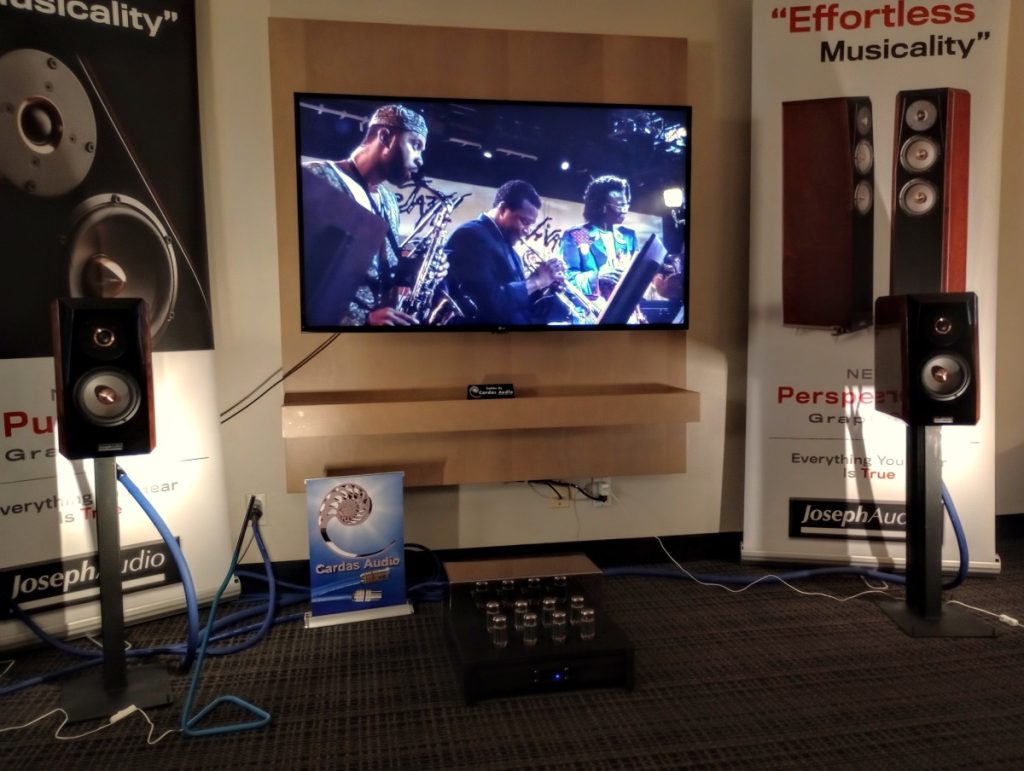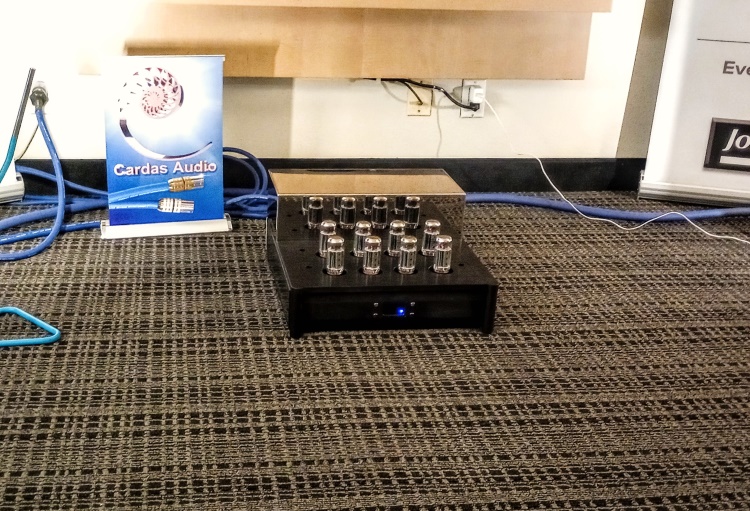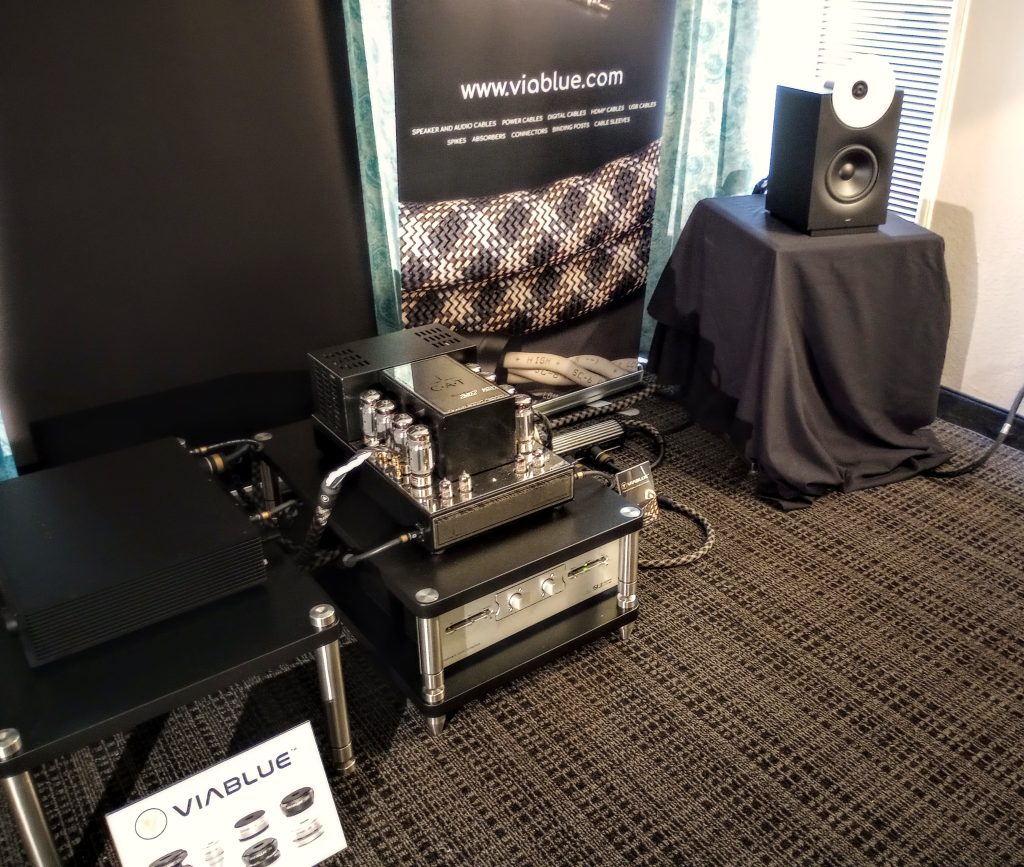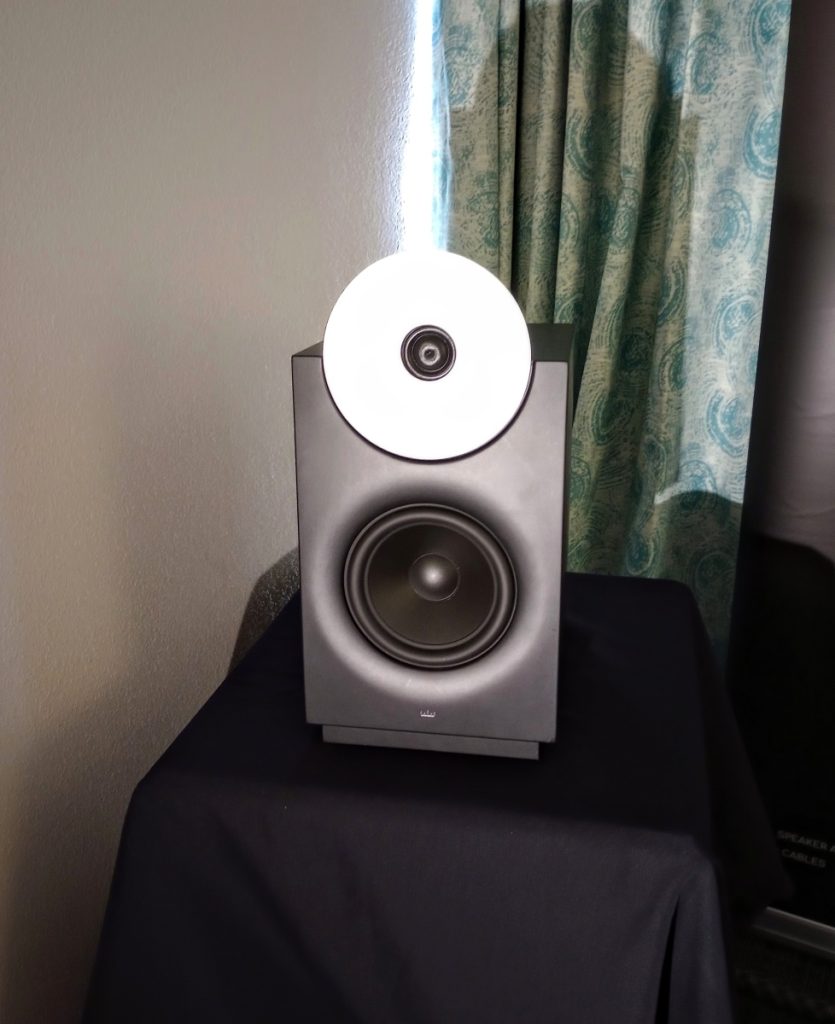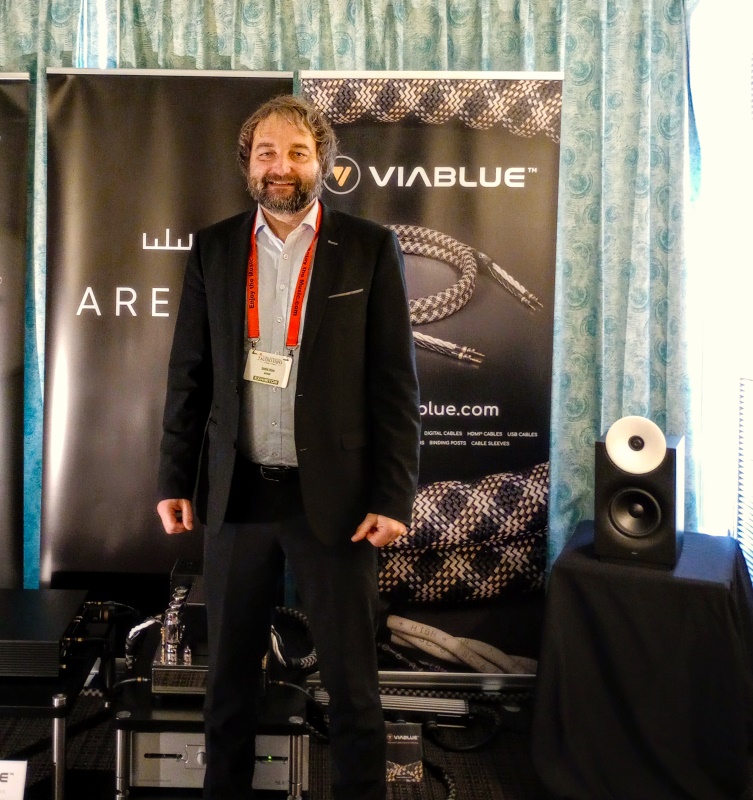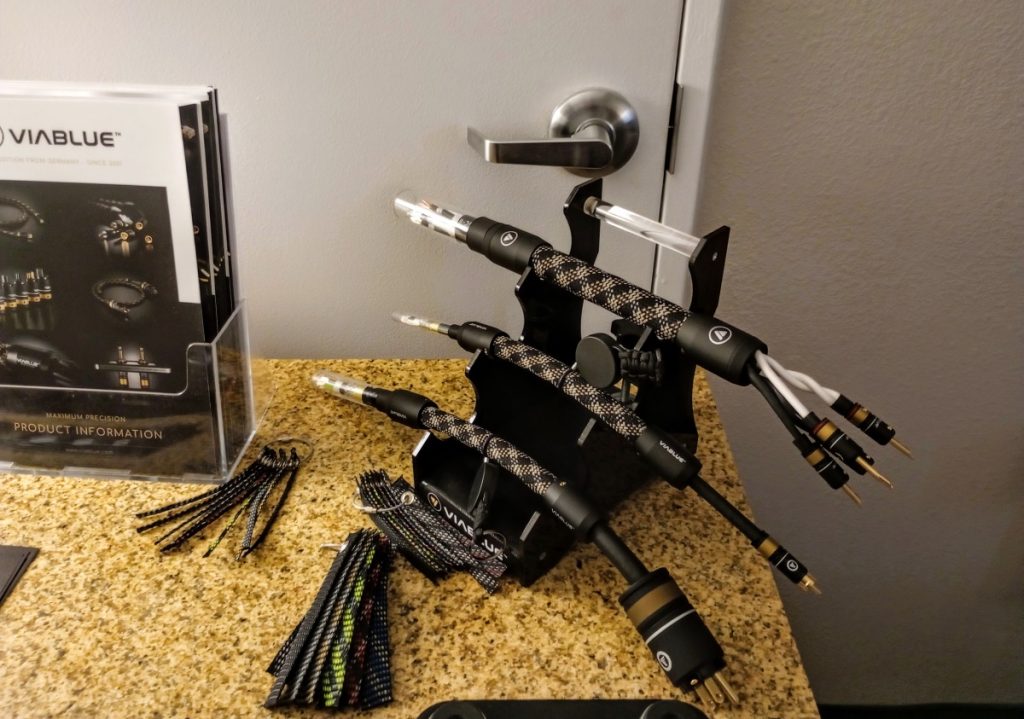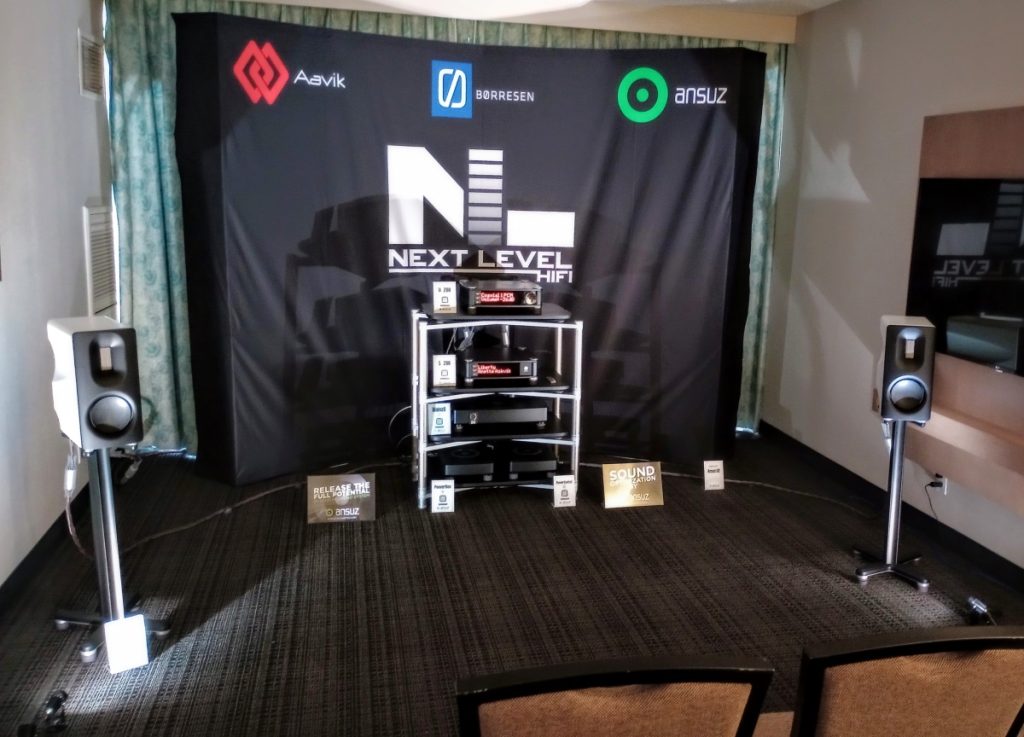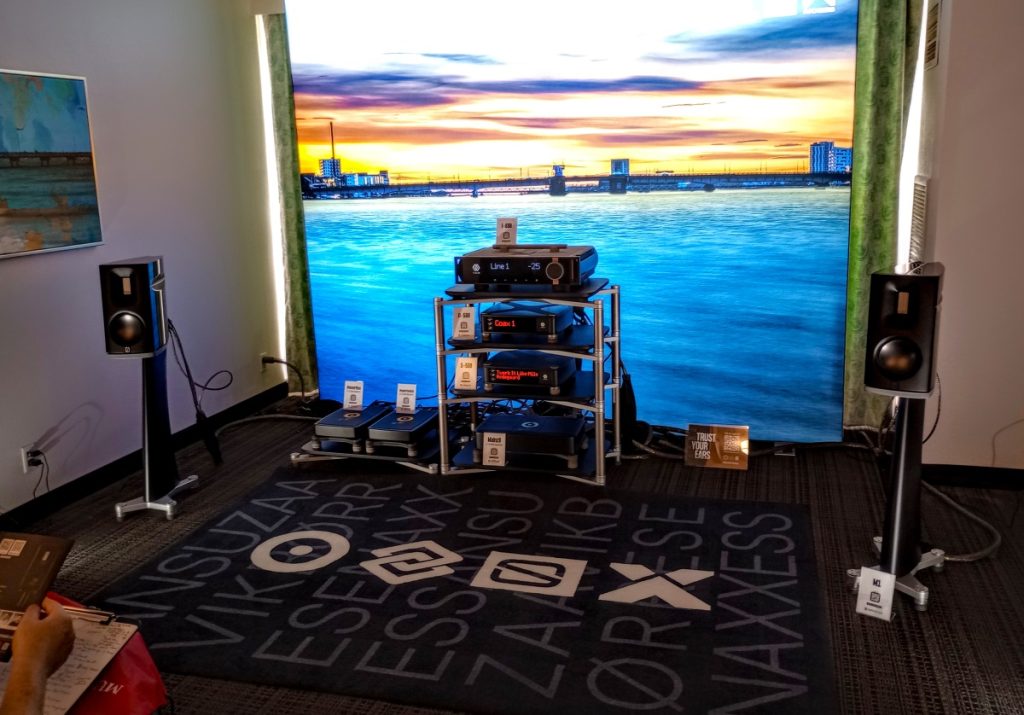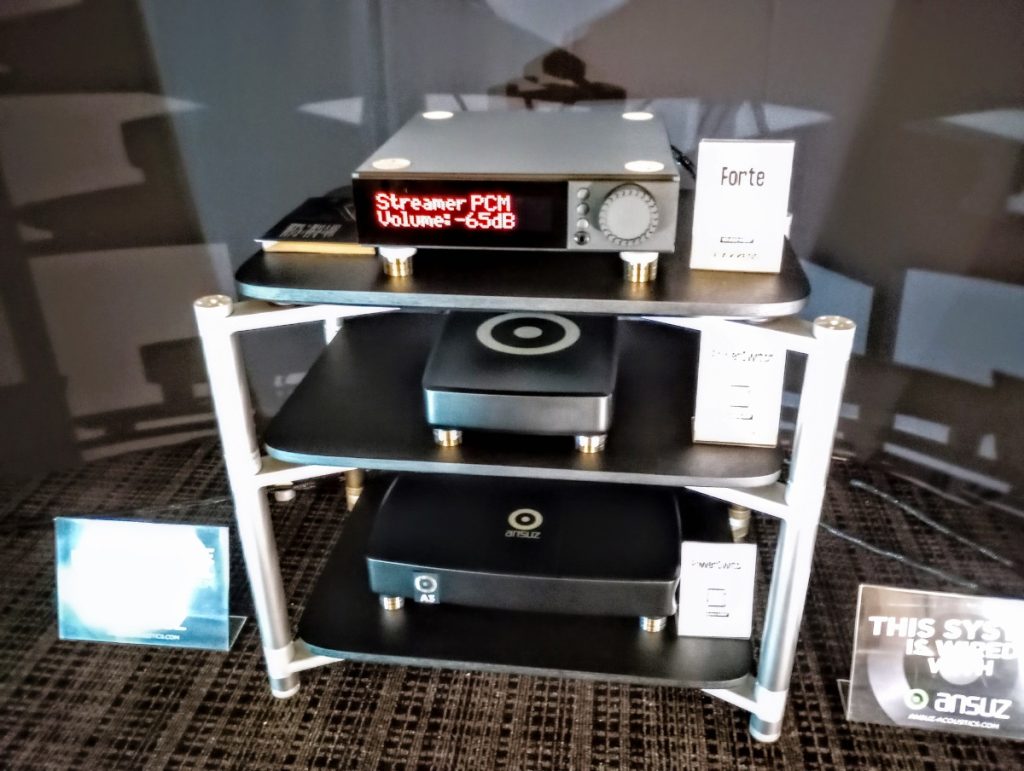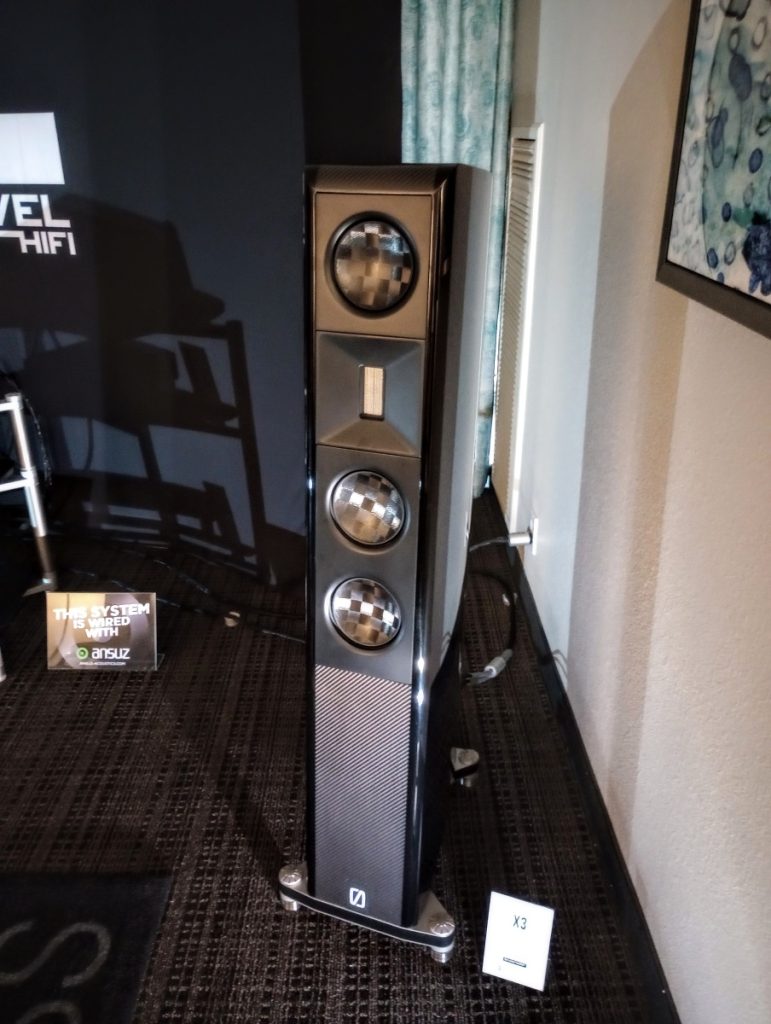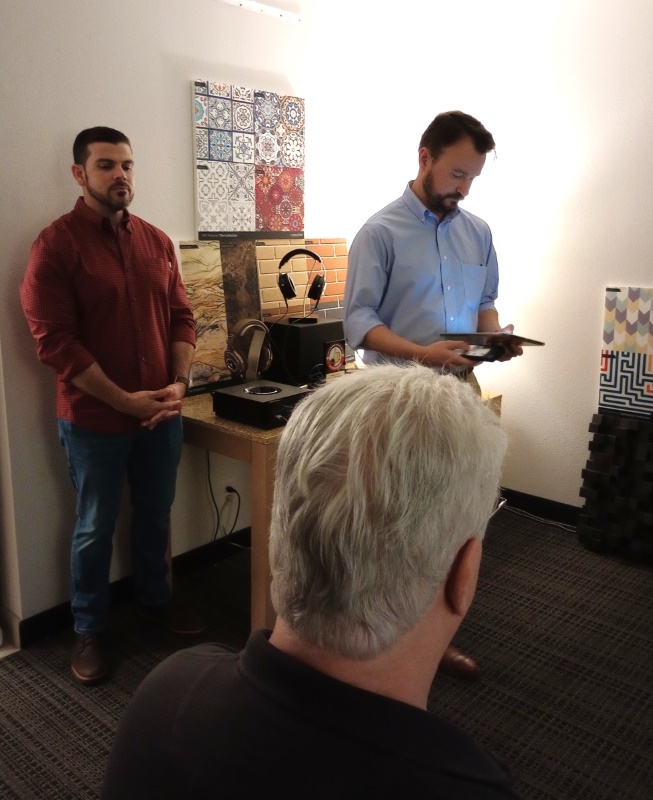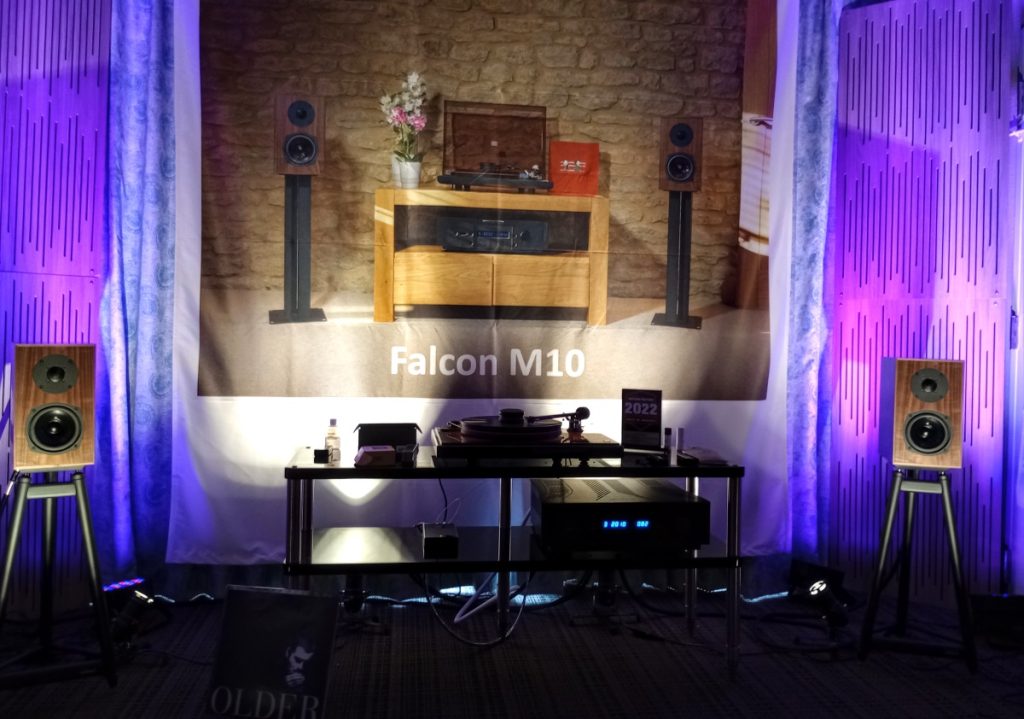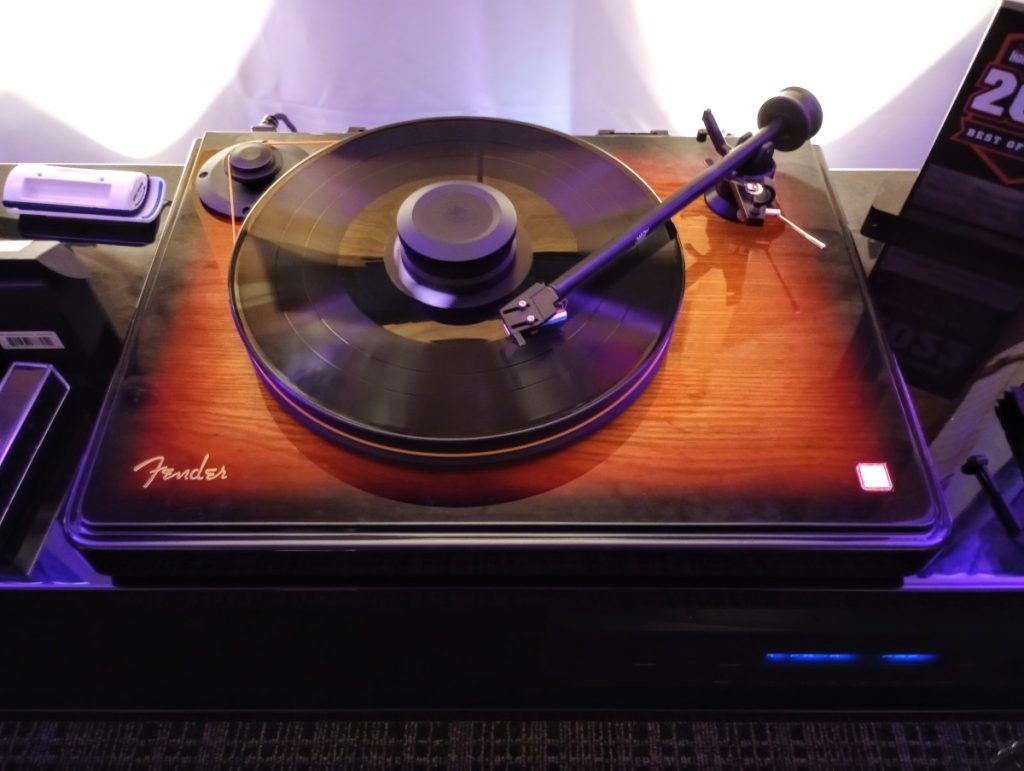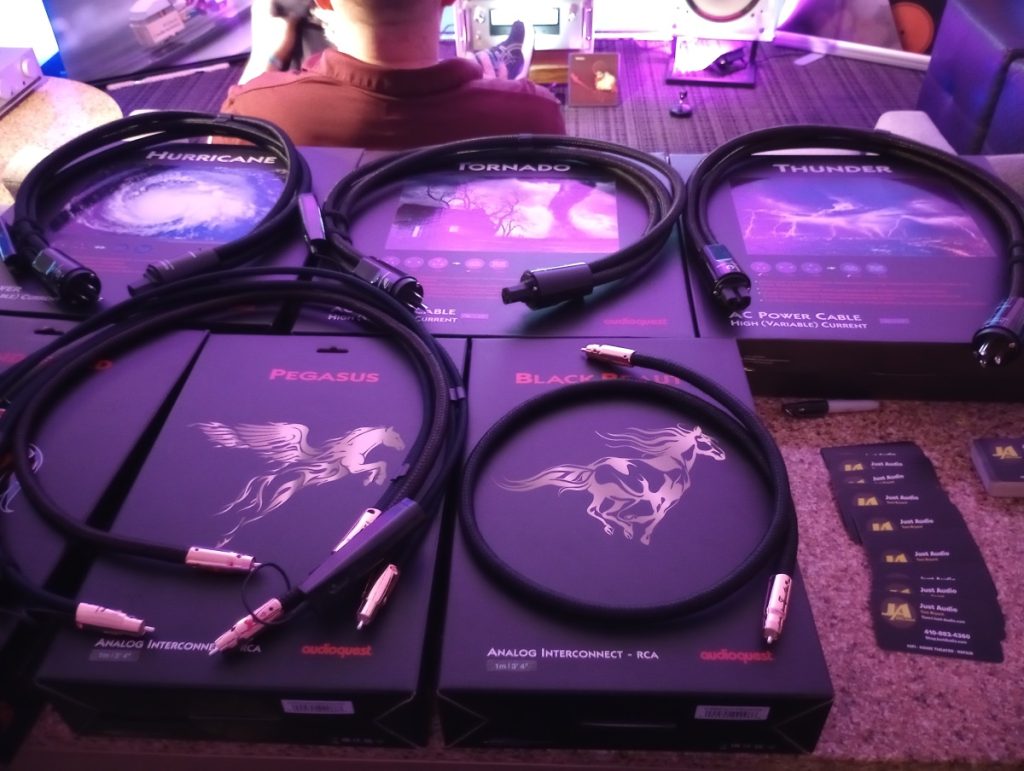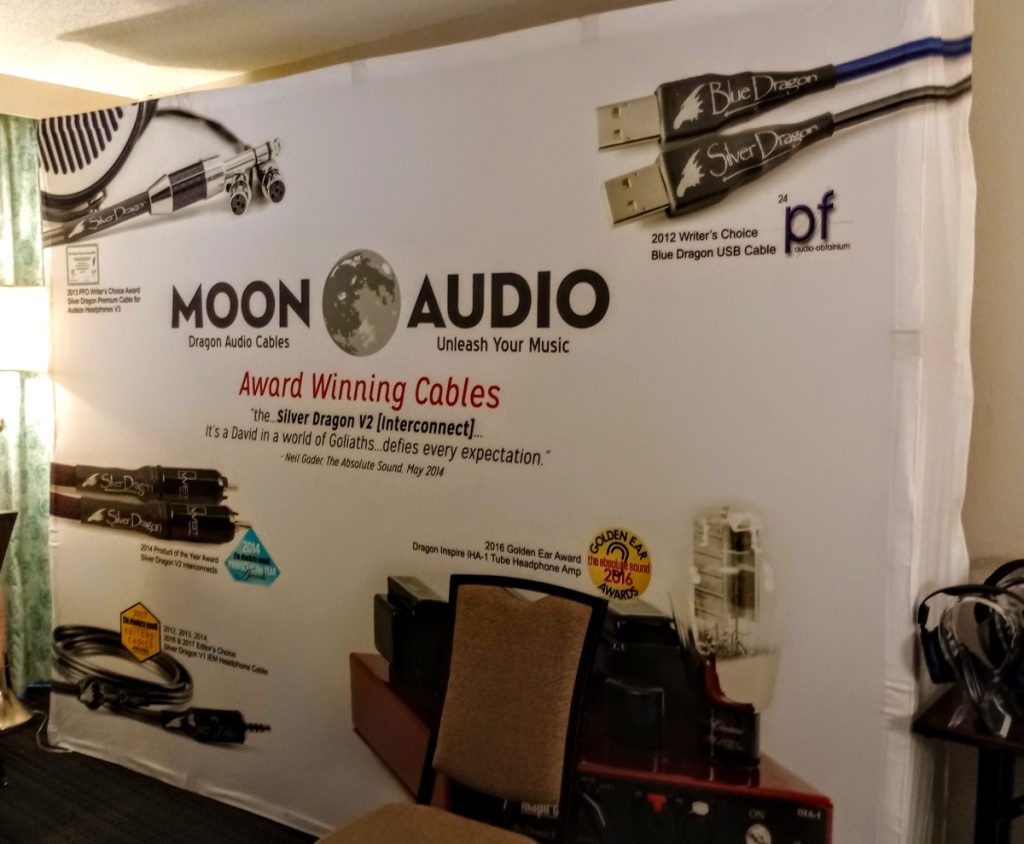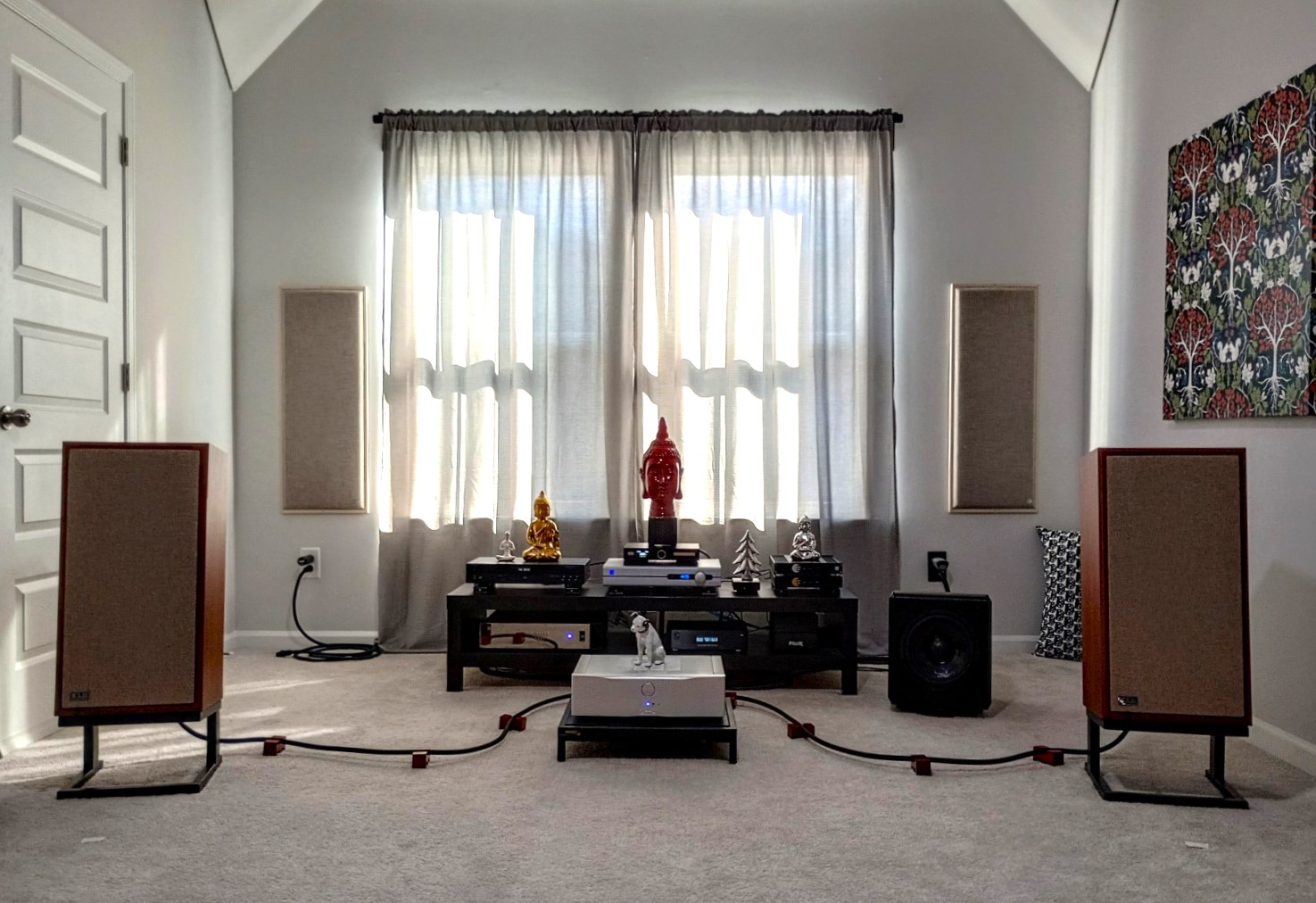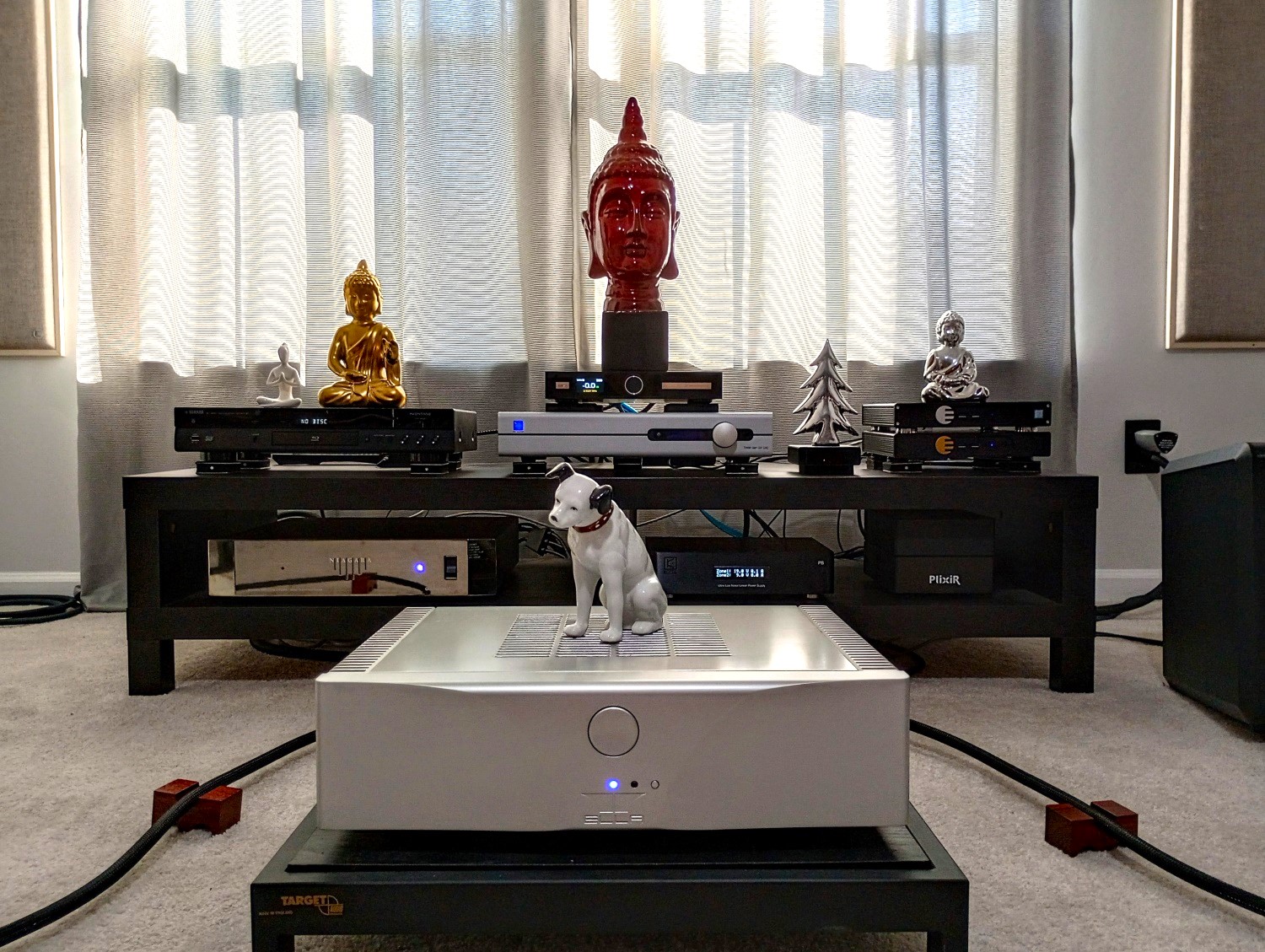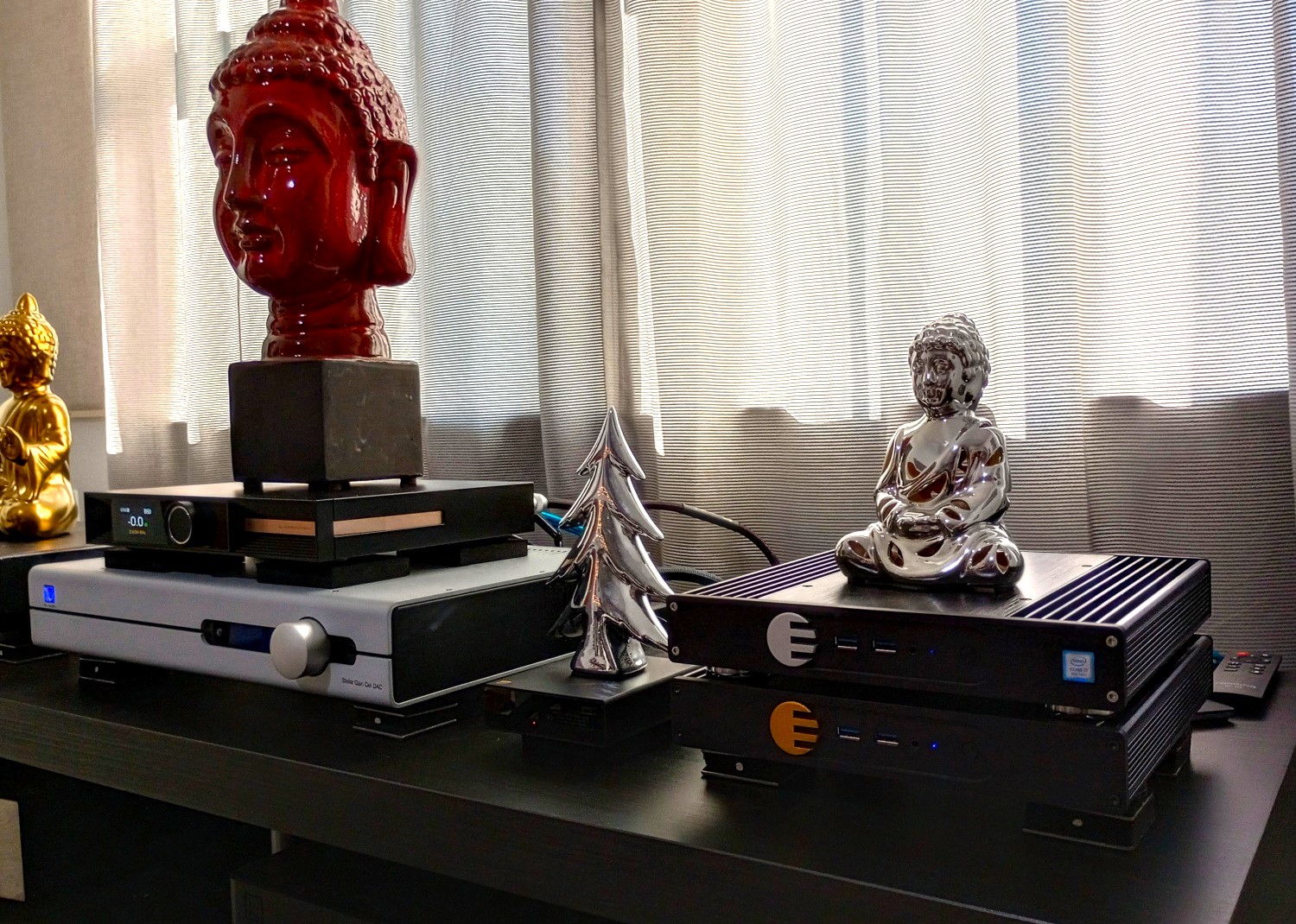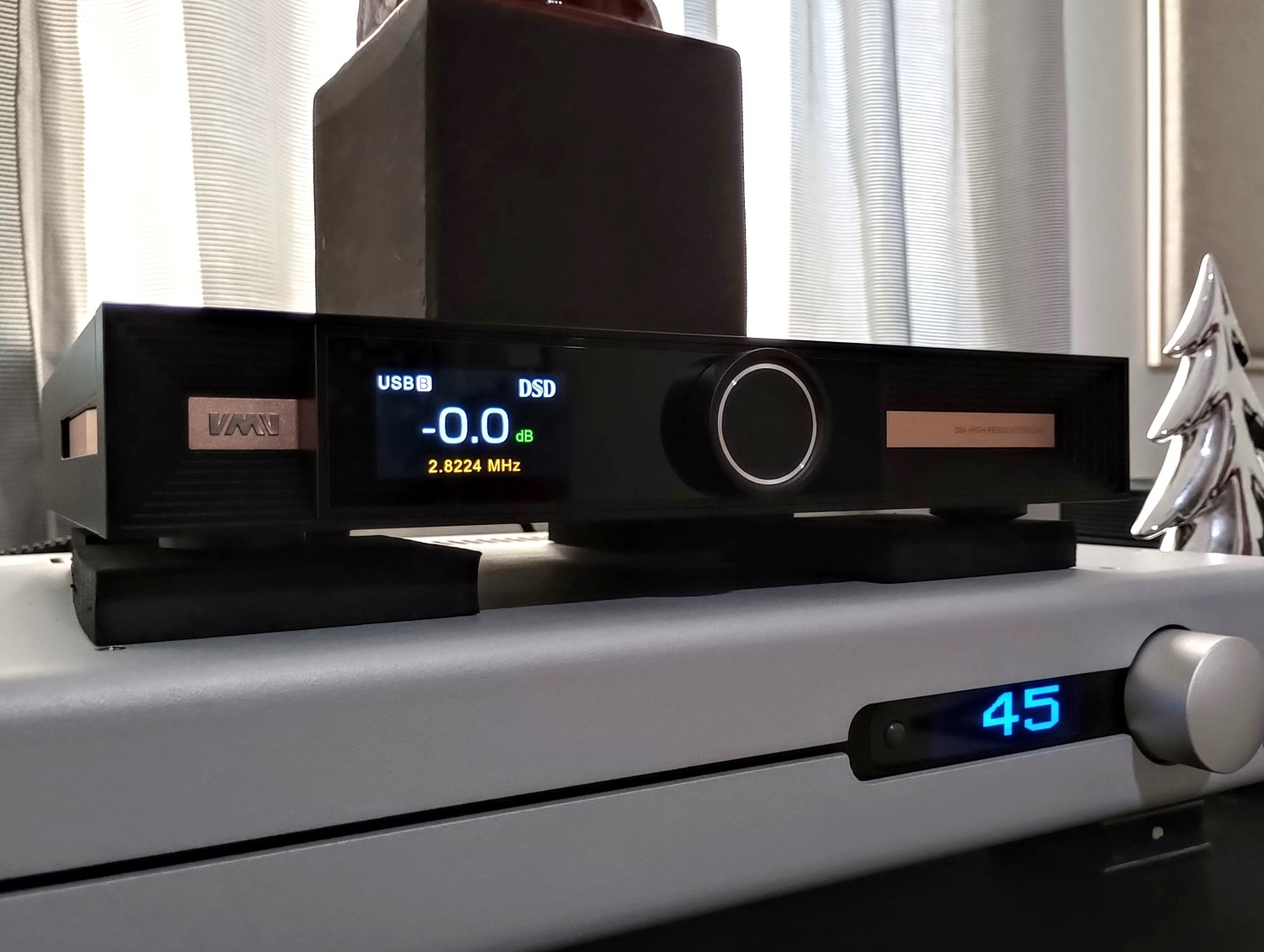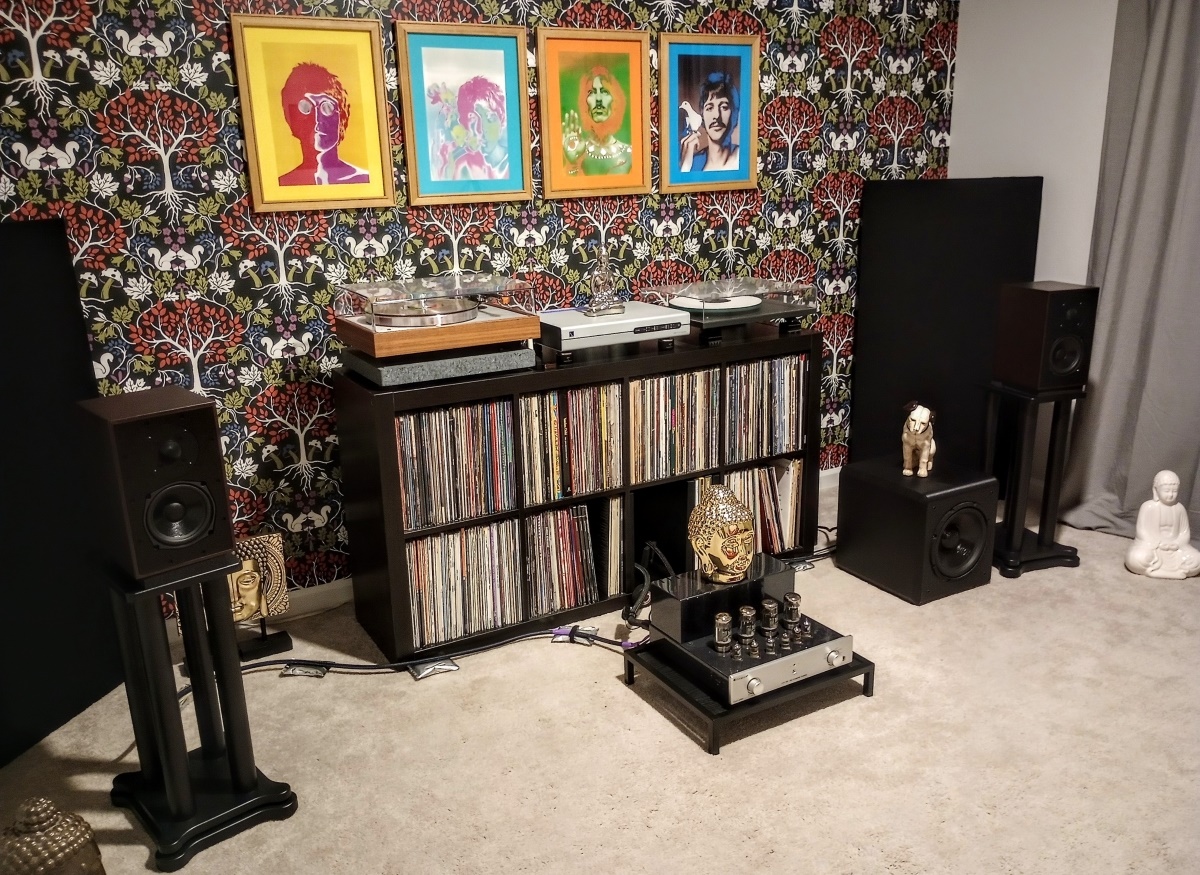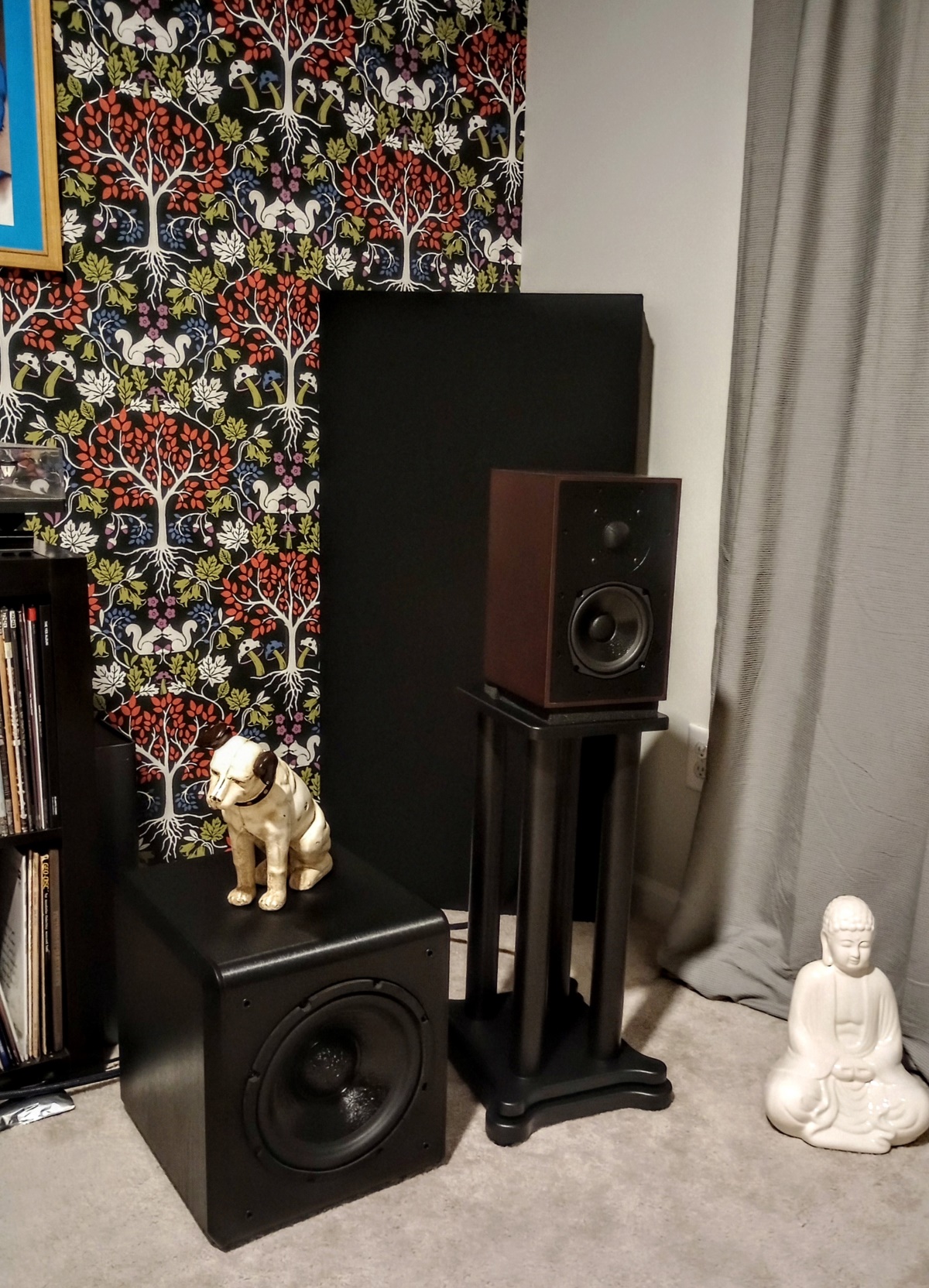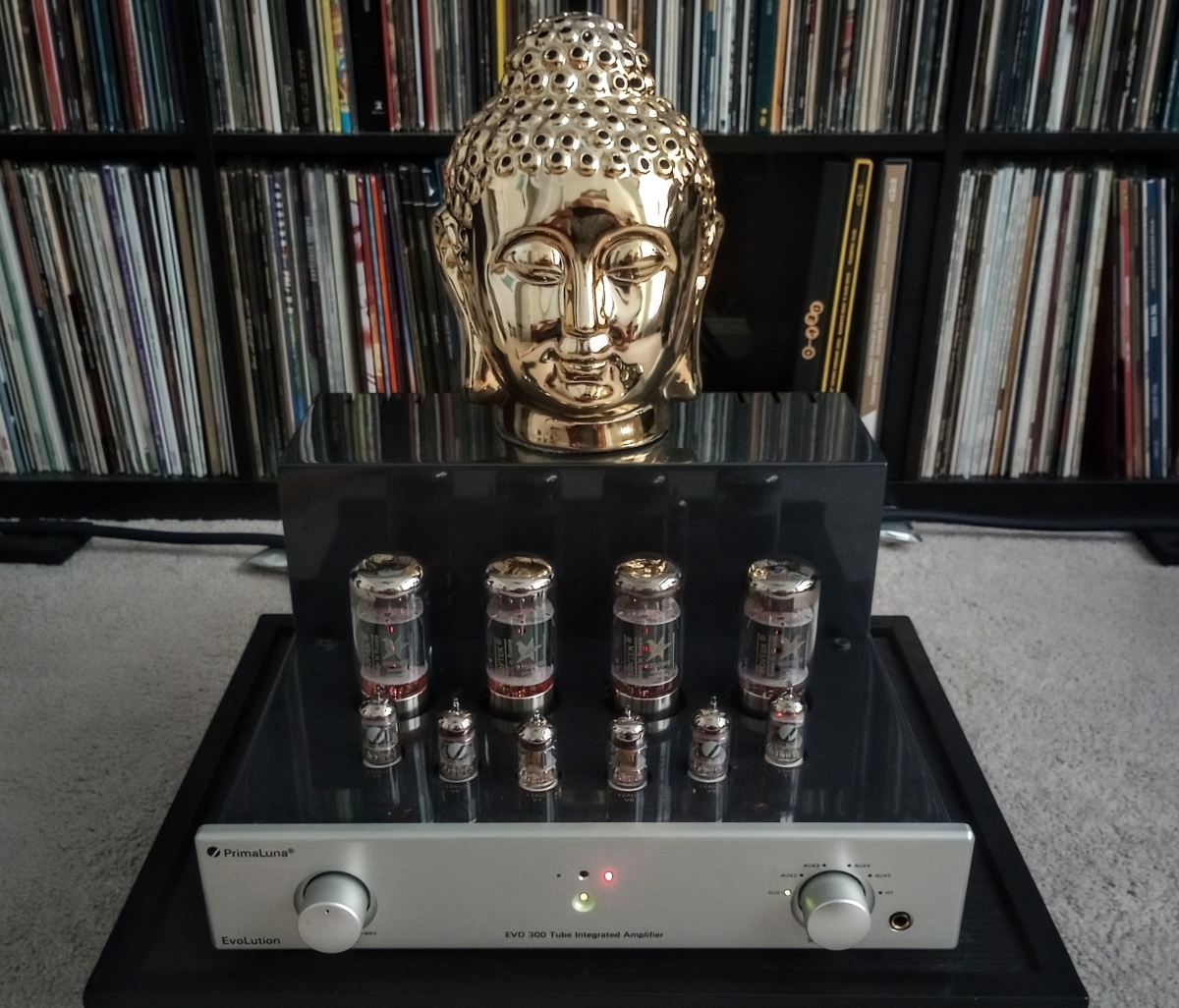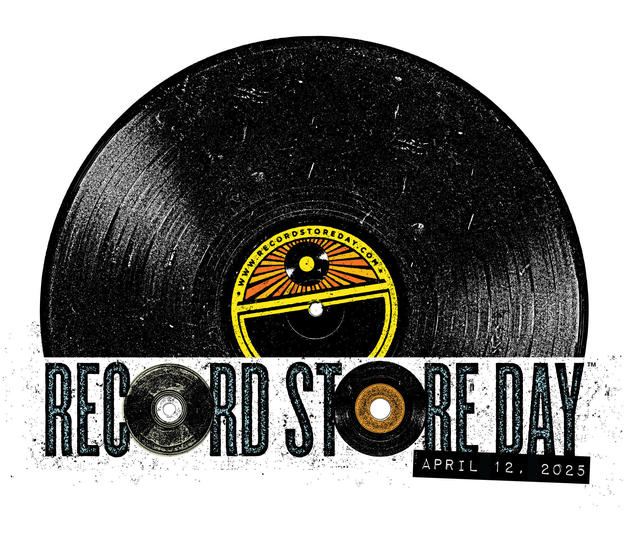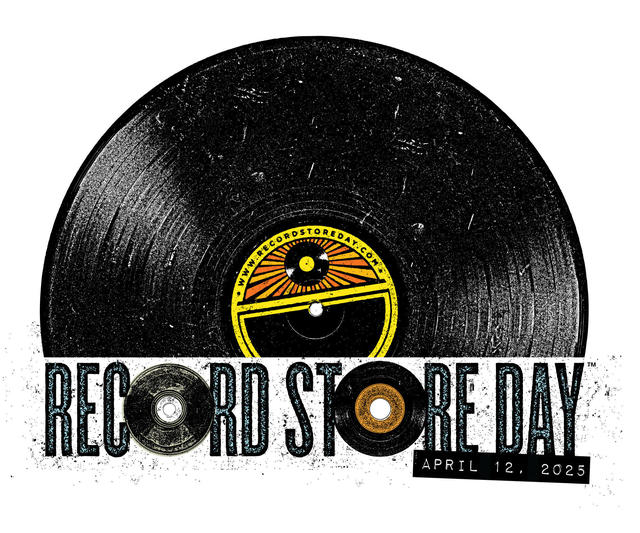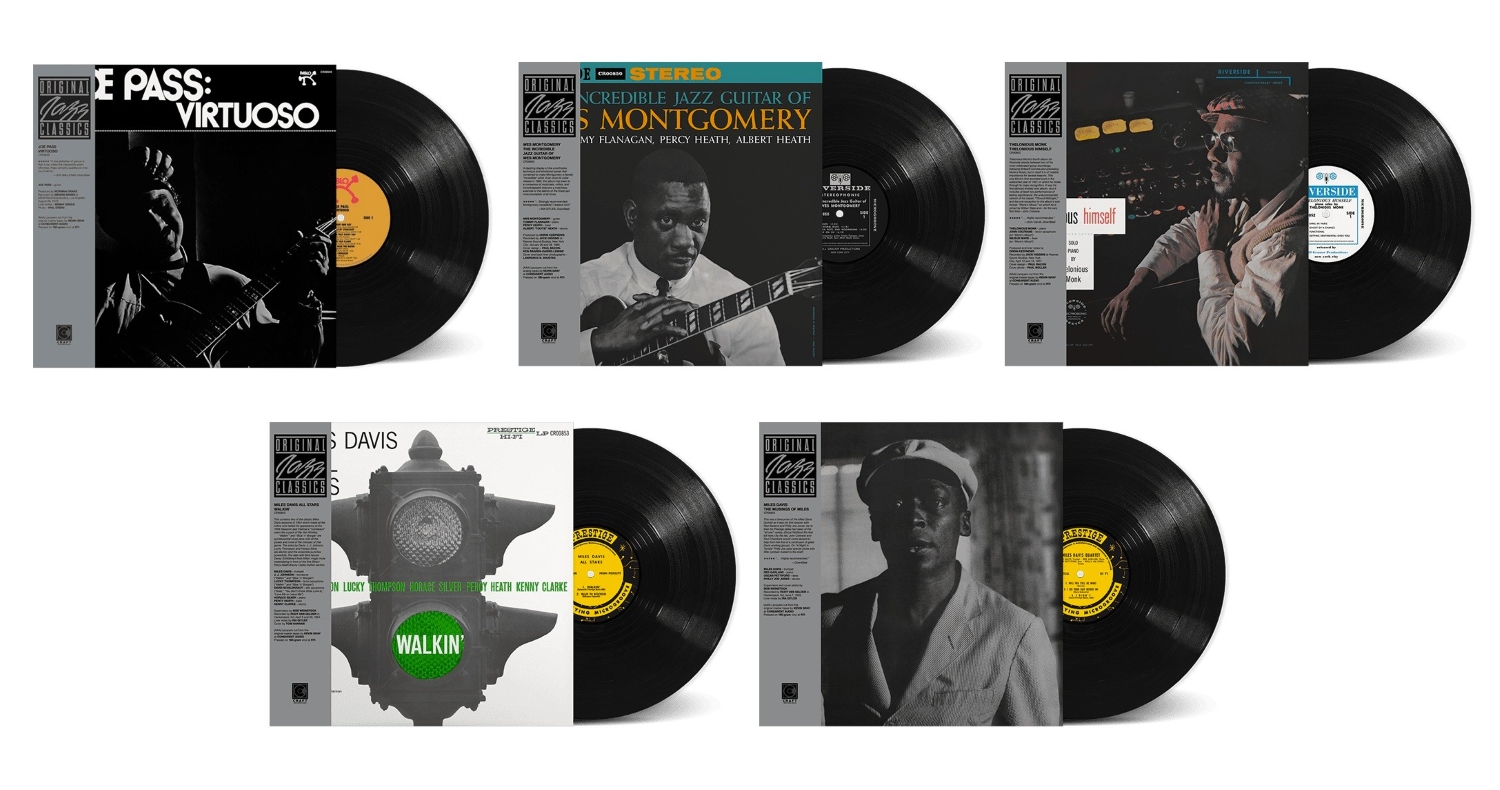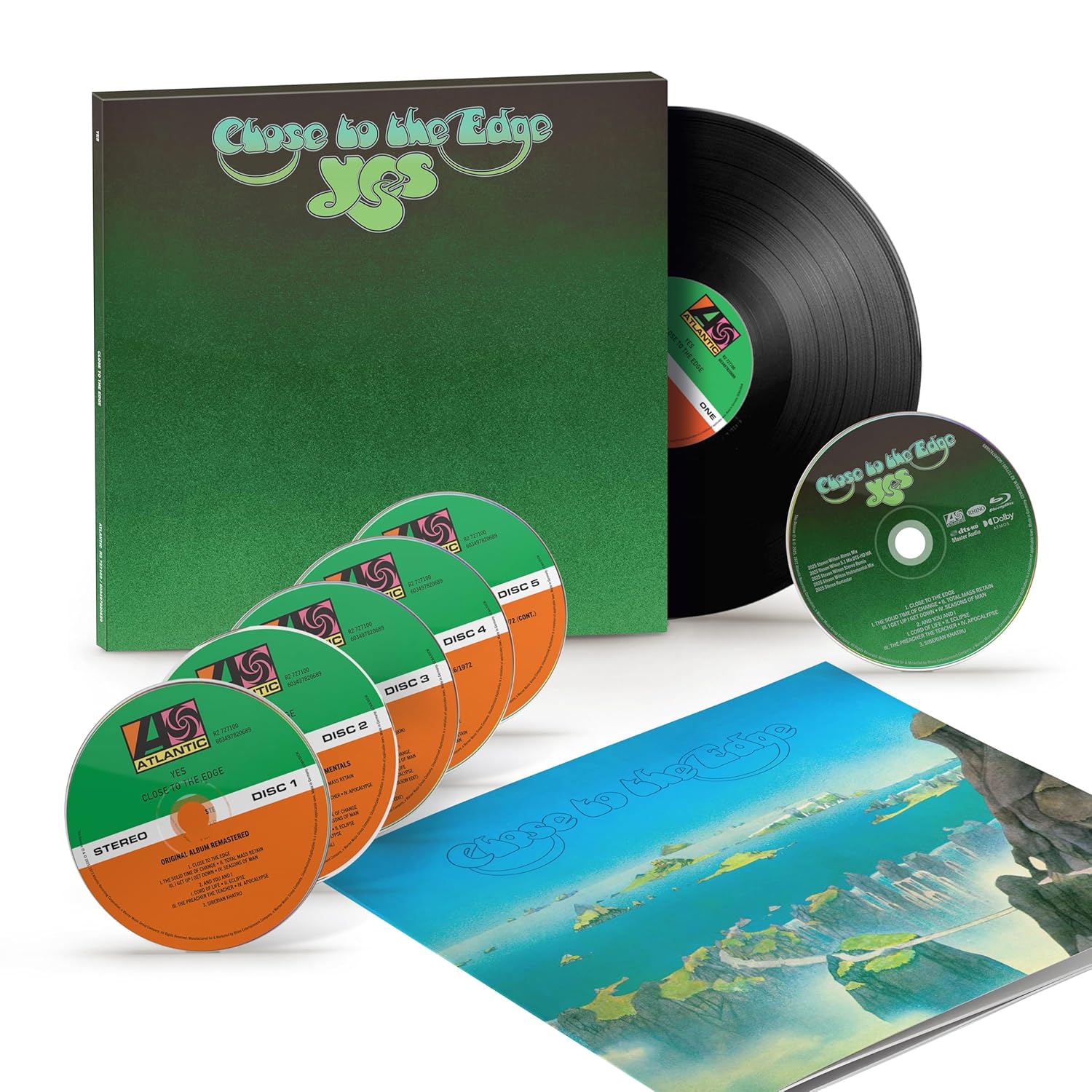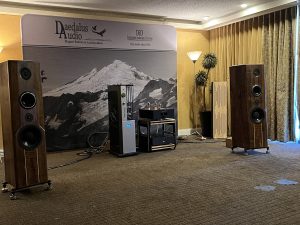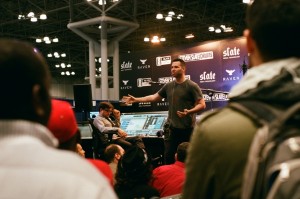During my show experience at FLAX, I basically live-posted capsules on Facebook from notable rooms I visited each day, saving my full coverage for after the weekend was over. Little did I know when I posted from the Focal Naim America room that I was opening a tempest in a teapot! At the point I visited the room, nothing other than a handout with a QR code identified the complement of loudspeakers and components in the Focal Naim setup. So I used the information I had from my Focal contact, Wendy Knowles, which identified the loudspeakers as the Focal Maestro Utopia EVO. Within minutes, multiple posters online were arguing whether the loudspeakers in my pictures of the room were actually the Maestro Utopia EVO, or the Sopra No. 3. I mean, it almost got ugly!
This lively discussion carried on for a couple of days; I spent a considerable amount of time checking out emails from Wendy, the information in the QR Code, and anything else that might be available online. The QR code took you to a site that listed a multitude of equipment that wasn't present in the room I visited—including both the Maestro Utopia EVO and Sopra No. 3 loudspeakers. Perhaps the Sopra No. 3 loudspeakers were in another room on a different floor, I have no idea. But I'm fairly certain from my photos that the loudspeaker in question was in fact the Maestro Utopia EVO. At least, they sure look like them as pictured on Focal's website!
The QR code thing is another reminder of how we as a society are moving headstrong toward a paperless flow of information, and hey—I'm basically okay with that. But my show experience proved to me that the QR codes on display in so many rooms in lieu of literature with equipment lists is a great idea, but definitely still a work in progress!
Joseph Audio featuring Doshi Audio and Cardas
I always try and make a point of checking out Jeff Joseph's room; mainly because Jeff is such an incredibly nice guy, who I feel like I could totally just hang out with in some other alternate version of my life! But the Joseph Audio room is always among the most musical you'll hear at any show, and the usual complement of Doshi Audio electronics that are typically always feeding Jeff's loudspeakers don't hurt things either! As always, all cables throughout the system are from Cardas, and the digital source was an Aurender A20 Reference network player.
The Joseph Audio loudspeakers sounded great, even playing online videos from NPR!
Jeff was showing his superb Pulsar 2 Graphene loudspeakers, which are an incredible value at just shy of $10k. Doshi Evolution Series tubed amplification and preamp were driving the Pulsars, and the sound was as great as ever—but this year, there was a twist! Right in between the loudspeakers, there was what appeared to be a 55-inch flatscreen tv, and a concert recording from Montreux featuring Miles Davis in a big band setting conducted by Quincy Jones was playing onscreen. And to my utter shock—the sound was astonishingly good, I mean ridiculously good! I generally don't expect to enter a room at a high-end audio show and encounter a video screen, except maybe at a more mainstream vendor. But this was a great experience; Miles was in top form, it was great to see Quincy Jones at work, and the sound was beyond reproach!
The Doshi Audio Evolution Amp was perfectly matched to the Joseph Audio loudspeakers.
As the selection from Miles Davis ended, Jeff then announced that he would next play a few tracks from an LA band Moonchild from an NPR tiny desk concert video. Again—I wasn't sure what to expect, I mean, videos in Jeff Joseph's room? But as the video commenced, I was completely struck by not only the impressively good sound, but also the superb quality of the video image. And Moonchild is an incredibly talented group of musicians! The trio of musicians are each multi-instrumentalists, and they were augmented by a drummer and a group of backup singers. Their style is kind of a jazz fusion of sorts, with smoky-seductive vocals from singer Amber Navran, and the combination of horns, woodwinds, and keyboards/synths from the group members was almost irresistible! To quote John Atkinson, I was pretty much gobsmacked! And I don't even know the provenance of the file playback, it apparently was from THIS video that Jeff was streaming from NPR's website. It made no sense to me, but I totally enjoyed the experience!
That is, to say, until a chap entered the room; I was seated next to Jeff, and he took the open seat beside me. And then proceeded to start shouting over the music right into my ear, how he heard Jeff's stuff way back in the day at CES, and blah, blah, blah—it just went on forever, and this guy was really obnoxious. I hung around for a few songs, then split, but Jeff's room was impressively entertaining with superb sound (as usual!) for such an unconventional setup. I ran into the same OWG* in an elevator later in the show and he was still shouting at everyone!
Aretai featuring Convergent Audio Technology and ViaBlue
Aretai is a loudspeaker manufacturer from Riga, Latvia; the loudspeakers they displayed at FLAX were from their Contra Collection. The model that was highlighted in the room was the Contra 100S, which is a smallish sealed box standmount that can be used for either in-room or desktop setups. The Contra 100S features a distinctive ring radiator high frequency driver assembly that's dominated by a large cylindrical waveguide assembly. That assembly encircles and encases the high frequency driver and protrudes from the cabinet's face—it very much resembles a horn (but these are not horn-driven speakers!). Janis Irbe, Aretai's founder and chief designer, told me that the waveguide is actually movable, and can be pulled forward to suit the listener's preference. And the waveguide/high frequency assembly can be easily removed; it can be ordered in a variety of colors, and apparently customers like the range of available choices. The Contra 100S also features dual 6-inch mid-bass/woofers, and is specified to reach down to 34Hz, although Janis assured me that the dual woofers will allow in-room measurements at least an octave lower than specified.
The Contra 100S is a really cool-looking loudspeaker that also offers incredible performance!
Aretai's room featured tubed electronics from Convergent Audio Technology; the amplifier in the system was a JL-5 Black Path Extreme Special Edition, and the preamp was an SL-1 Legend Black Path Extreme. The digital source was a network player from Aurender. The impressive and robust looking cables, spikes, absorbers, and room enhancement products in the system were supplied by German manufacturer ViaBlue.
Janis Irbe, Aretai's founder and chief designer.
Janis had emailed me prior to the show, and asked me to have a list of my most demanding tracks for evaluation of his loudspeakers at the show, and he also presented a playlist of tracks he'd have available on his server. Of course, it was a mad dash on my part to even get to the show, so I didn't compile a tracklist, but I basically have certain tunes etched in my brain that I use for equipment evaluation, so no biggie. Server and internet access issues occurred at various intervals throughout the show, and there was no Qobuz access during my visit to Aretai's room. But I'd checked out Janis' playlist, and there was plenty there that I was comfortable with!
The ViaBlue cables are impressively well made.
Playback started with "Flight of the Cosmic Hippo" by Bela Fleck and the Flecktones, which was a really good acoustic/electric introduction to the Contra 100s' imaging capabilities. That was followed by jazz singer Jane Monheit's "Honeysuckle Rose," which features a superb walking bass intro that showed the diminutive loudspeaker's in-room bass response to really good effect, and Monheit's voice was exceptionally lyrical and solidly centered in the soundstage. Janis then played "Bubbles" from Yosi Horikawa, an electronica piece that bounced around the room behind and beyond the soundstage. The final track he played was "2049" from composer Hans Zimmer from the Blade Runner 2049 soundtrack; the bass content was impressively deep, such that I'd have sworn a sub or two were tucked away in the room somewhere! Overall, the Aretai/Convergent/ViaBlue combo made quite the impression, and were supremely musical—I'll definitely keep my eyes on these guys!
Next Level HiFi featuring Aavik Acoustics, Ansuz Acoustics, and Borresen Acoustics
AGD—Audio Group of Denmark—showed again this year in cooperation with their Chicago area dealer Next Level HiFi. Next Level had three rooms at FLAX, where they showcased AGD's three brands, Aavik Acoustics, Ansuz Acoustics, and Borresen Acoustics. Amplifiers, preamplifiers, digital sources, and all electronics fall under Aavik's umbrella; the Ansuz brand features AGD's cables, power distribution, and resonance control products; while the Borresen brand spotlights AGD's loudspeaker production. All products displayed in all three rooms are manufactured by AGD, and they're built of exotic materials to nearly unbelievable tolerances—an AGD system is any audiophile's dream!
One of the three Next Level HiFi rooms on display at FLAX.
I frothed at the mouth over the AGD equipment last year, so I'll spare you a rehash. In addition to the excellent system symmetry the Aavik devices provide to the mix, I absolutely love the large displays, which can easily be read from across a room. The jewel-like Ansuz cables are built to a standard that few others can approach. And the Borresen loudspeakers utilize exotic construction and materials that contribute to a cohesive sound that will dazzle you like few other speakers that exist in the high end. An AGD system is definitely the lottery dream of many audiophiles.
The new Axxess Forte is a tremendous performer at a surprisingly low price point.
The Borresen X3 offers performance on par with its much more expensive siblings.
But the real reason to check out the AGD offerings at FLAX this year was the introduction of their new entry level brand, Axxess. Which featured its debut product, the Forte, which is an all-in-one device that is basically an integrated amplifier with built-in DAC and streamer modules. The show also featured the debut of a new entry level Borresen loudspeaker line, the X series, with the new X3 on display. Everything in the entry level system shows a generous helping of serious trickle down from the megabuck technology employed in the full-line AGD brands. And the Forte and X3 combined clock in at under $20k! Let the rejoicing begin!
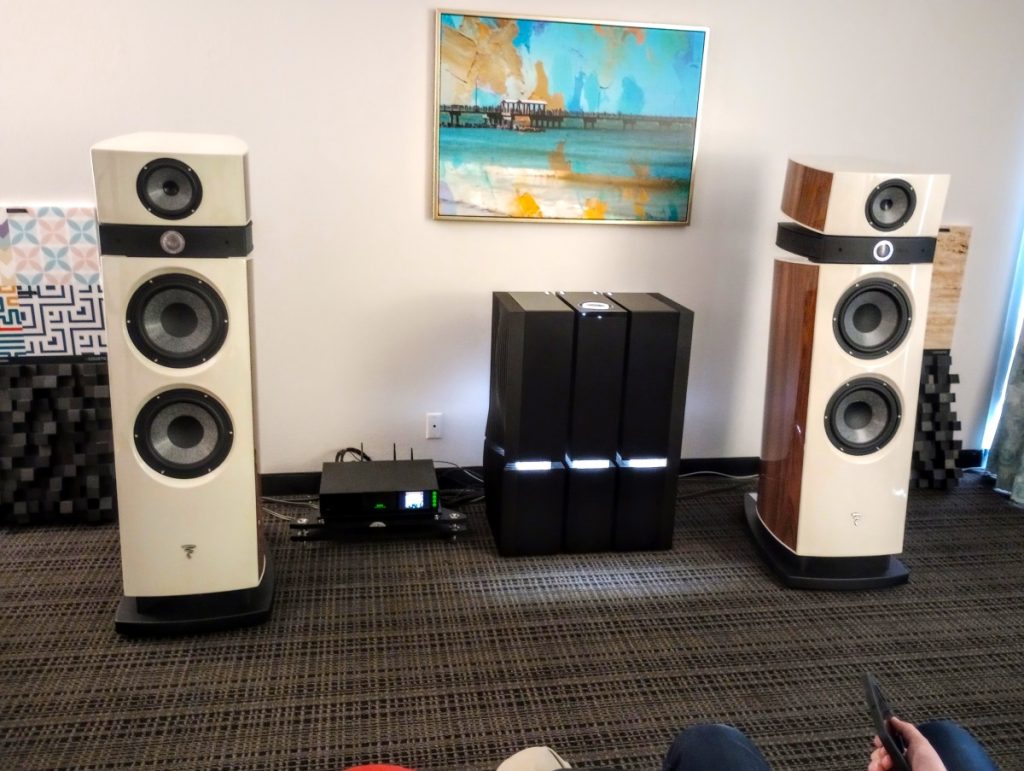
Focal Naim America with Vicoustic
Focal Naim's room featured loudspeakers and headphones from Focal, Naim Statement electronics, as well as digital equipment from Naim. No cables were listed in the online or in-room information, or on the QR code information. Acoustic panels in the room were supplied by Vicoustic. The room was crammed with listeners, and it took a few minutes for me to maneuver myself into anything resembling a good position to evaluate the sound coming from the system.
The guys from Focal Naim control playback of the Naim Statement system that was connected to the massive Maestro Utopia EVO loudspeakers. The sound was truly impressive!
As noted in my introduction to this latest segment of show coverage, there was some controversy over which loudspeakers were actually on display in this room. I feel fairly confident now in proclaiming that they were in fact the gargantuan Focal Maestro Utopia EVO, and not the Sopra No. 3 as claimed by some. The room featured a massive pair of Naim Statement mono amplifiers, as well as a matching Naim Statement preamplifier. The digital source in use also came from Naim, an NDX 2 Network Audio Player/DAC. The sound in this room was absolutely superb, as should be expected from the monster complement of Naim electronics driving the big Focals. A guy beside me asked "What were the big black boxes in the middle of the room—did they serve some purpose?" One of the reps in the room explained that they were the amps and preamp; this guy was pretty flabbergasted by the scale of the Naim equipment powering the huge Focals. Trust me, he wasn't alone—this monster system produced a monster sound!
MoFi Distribution featuring Falcon, BAT, Mobile Fidelity, and Solid Steel
Mobile Fidelity branded loudspeakers garnered a lot of attention at FLAX, but some of the equipment they distribute was also on display at the show, and was pretty cool as well. This room highlighted two pairs of Falcon loudspeakers, the limited LS3/5a Gold Badge standmount speakers, and the M10 speakers. Balanced Audio Technology provided the system power with a VK3500 integrated amplifier. MoFi also provided the system's source, a Precision Deck turntable with the limited edition Fender swamp ash sunburst finish plinth. As well as a MoFi StudioPhono phono preamplifier; the turntable was fitted with a MoFi Master Tracker cartridge. All stands and racks were provided by Solid Steel.
I only got to hear the less expensive M10 loudspeakers during my visit. Both the M10 and LS3/5a Gold Badge are very small as far as bookshelf loudspeakers go; but the M10 cabinets are actually larger and heavier than those of the renowned LS3/5a. The -3 dB down points for both speakers is virtually the same, and they both share the same response curve of 70Hz - 20kHz. The cabinets for both are made in the same Italian factory; the M10 is a ported design, and the LS3/5a Gold Badge uses a sealed box. While the LS3/5a Gold Badge is undoubtedly the "gold standard" among small loudspeakers, the M10 produced a sound that was musically refined, if not quite on the same level as their more expensive sibling. Still, the M10 was a very compelling performer!
The MoFi Precision Deck turntable has that really cool Fender sunburst finish paint job!
The other really cool item in the Mobile Fidelity Distribution room was their own MoFi Precision Deck turntable, which provided the analog source for the demo. It's an incredibly cool-looking turntable, and from what I heard in the room, an excellent performer as well!
Just Audio.com
Somehow or another, I ended up getting an Instagram follow request from Just Audio.com, which is a Baltimore-area high-end dealer that sells tons of equipment online and in a brick-and-mortar store. But their Instagram feed also features a steady flow of vintage gear they've acquired and rehabbed for resale that I enjoy lusting over online—staring at those vintage gear posts really takes me back! Anyway, I really wanted to check out their two rooms, which, more than anything else, exuded this kind of "Crazy Eddie" energy from the seventies commercials. It's an interesting vibe, to say the least!
Quite a selection of higher-end Audioquest cables were on display and available for purchase.
One of the rooms featured a vintage rack of Pioneer gear from the seventies, with amp, preamp, equalizer, open reel deck, and a receiver; the rack was flanked by a pair of JBL Studio Monitors that were encased in crystal acrylic cabinets. A neon Just Audio sign cast an eerily effective, nearly psychedelic electric blue light through the JBL's, and everyone in the room was absolutely digging it! Moving onto the static displays, the room also featured a ton of current high-end cables and accessories; one table featured the current range of megabuck AudioQuest interconnects and power cables. All in all, a very interesting room, and a really great face to match to my Instagram vintage gear lust habit!
Moon Audio
I've always recognized Moon Audio for their cables; back in the early days of USB computer audio, they were one of the first cable manufacturers to offer a high-end alternative to off-the-shelf USB cables, like their Dragon and Silver Dragon lines. Which at the very least gave the impression (if by nothing else other than their well-made appearance) that someone out there was actually concerned with USB quality!
Headphones from many manufacturers were available to try out in Moon Audio's room.
Well, apparently they're very big into servicing high-end headphone playback, because almost the entire room seemed focused on headphones, amps, and DACs from just about every manufacturer imaginable. I mean, there was headphone gear from Astell & Kern, Audeze, Aurender, Focal, Dan Clark Audio, Fostex, HiFiMan, iFi, Sony—heck, there were even electronics from DCS in the room—seriously? I don't generally engage in a ton of headphone listening in my normal routine, but I'm obviously way behind the curve on this one. If you're really into cans, you should definitely check them out!
All photos by the author
* Urban Dictionary: OWG = Old White Guy




